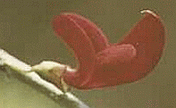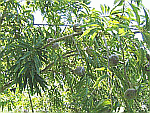
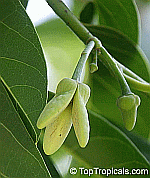

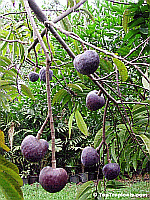
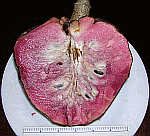
|

Pink var., Jamaica - Davison Shillingford
Description: Small tree, 5-10 m tall (16-32 ft), with grey bark and spreading branches; leaves simple, lanceolate and alternate, up to 20 cm long (8 in); flowers pale greenish-yellow and fragrant; fruit derived from complete fusion of carpels, is large, 8-16 cm diameter (3-6 in), heart-shaped or round, relatively smooth and shiny, with hexagonal markings on surface; depending on variety, of which there are several, ripe fruit color varies from yellowish green to tan with pink blush to pink and brownish red, tan with pink blush being the common variety in Dominica; pulp varies from cream to pink, has pleasantly sweet flavor and custard-like texture, with several black seeds; fruiting June – October.
Plant Family: Belongs to the Annonaceae family, which includes Sugar Apple (A. squamosa), Soursop (A. muricata) and Ylang Ylang (Cananga odorata).
Natural Habitat: Low-lying areas of tropics; adapted to wide rage of soils and rainfall; flourishes best with moderate rainfall and good drainage; in Dominica, especially common at lower, drier elevations of west coast; propagation usually by seed, but also by budding or grafting on other Annona rootstock; several young trees in economic crops section of Gardens.
Origin and Distribution: Thought to be native of the West Indies, but widely cultivated for fruit throughout tropics.
Uses: Cultivated primarily for its very pleasant, edible fruit; medicinally, many of its uses derived from the Caribs; leaves used in tea for diarrhea; tea brewed from mixture of its leaves and those of Pigeon Peas (Cajanus cajan) drank as fever remedy; pulped bark used in poultice for sprains and dislocations; and powdered seeds used for lice.
Indigenous Legends and Anecdotes: From its large, heart-shaped fruit, it gets the common name, Bullock’s Heart; and from the fruit’s custard-like taste and texture, it gets another common name, Custard Apple.
References:
Robert A. DeFilipps. Useful Plants of the Commonwealth of Dominica, West Indies. Smithsonian Institution, Washington, D.C. 1998
Dan H. Nicolson. Flora of Dominica, Part 2: Dicotyledoneae. Smithsonian Institution, Washington, D.C. 1991
C.D. Adams. Flowering Plants of Jamaica. University of the West Indies, Mona, Glasgow University Press 1972
Penelope N. Honychurch. Caribbean Wild Plants and Their Uses. Macmillan, London, 1986
H.F. Macmillan. Tropical Planting and Gardening. Macmillan, London 1956
Julia F. Morton. Fruits of Warm Climates. Julia F. Morton, Miami, FL. 1987
|

